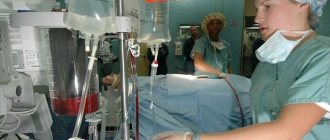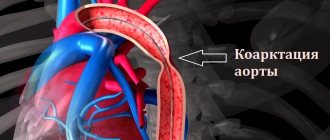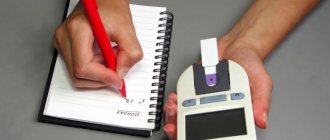Published: 08/13/2021 10:52:00 Updated: 08/13/2021
Hypoglycemia refers to a decrease in blood glucose levels to critical values. This is a dangerous condition that leads to disruption of the brain’s internal organs, and in a severe stage – to irreparable consequences or death due to hypoglycemic coma.
The symptoms of this condition are varied and depend on the cause of the pathology and the characteristics of the individual patient. Timely diagnosis and control of sugar concentrations make it possible to prevent serious complications and maintain the usual way of life.
Causes of hypoglycemia
A decrease in blood sugar levels is not a disease, but a condition that occurs due to a number of disorders of carbohydrate metabolism in the body.
Glucose, as a source of energy, determines the functioning of internal organs and the condition of a person as a whole. The brain is especially sensitive to a drop in sugar concentration. It works more intensively than all other organs, consumes an increased amount of “fuel”, is not able to store it and therefore is completely dependent on the continuous supply of glucose through the bloodstream.
In the body of a healthy person, excess glucose from carbohydrates received from food is stored in the liver in the form of glycogen - a molecule consisting of many interconnected glucose molecules, which, if necessary, is broken down and absorbed into the blood. This ensures the smooth functioning of organs. Thus, any liver pathology can lead to hypoglycemia.
In addition, hormones significantly influence glucose metabolism:
- pancreas: insulin (responsible for the accumulation of glucose in the form of glycogen and reducing its level in the blood) and glucagon (stimulates the breakdown of glycogen, which causes an increase in sugar levels);
- adrenal glands: adrenaline, cortisol, growth hormone (increases sugar);
- thyroid gland: thyroxine and triiodothyronine (increase sugar).
Hypoglycemia is most often observed in diabetes mellitus.
On the one hand, the patient takes glucose-lowering medications. On the other hand, glucose from the liver enters the blood slowly. This leads to the fact that at some point the sugar concentration may drop to critically low values. This condition also occurs as a result of diseases of the gastrointestinal tract with impaired absorption of glucose, renal failure (increased excretion of sugar in the urine), cancer of the pancreas and some congenital pathologies.
Hypoglycemia resulting from disease is called pathological. In contrast, physiological hypoglycemia develops in healthy people during fasting, dehydration, emotional stress or excessive physical activity, taking certain drugs and alcohol.
In women, hypoglycemia is sometimes observed during pregnancy due to the fact that part of the mother's glucose is spent on fetal development. Hypoglycemia in children develops in the first hours or days after birth and can be temporary or permanent. Risk factors include prematurity, maternal diabetes, birth asphyxia, and congenital pancreatic anomalies.
Caution: High Blood Sugar
Diabetes mellitus is a disease in which the level of sugar (glucose) in the blood increases. Currently, the world is experiencing a real epidemic of this disease: every eleventh person on the planet suffers from diabetes, and according to experts, in 2030 every tenth person will be “diabetic”.
High blood sugar is very dangerous. Like corrosion, it “corrodes” all organs. The eyes, kidneys, nerves, and heart suffer the most. Patients with diabetes die from heart attacks, strokes, and lose their vision. They develop kidney failure and have to undergo hemodialysis (blood purification using an artificial kidney) several times a week. Sometimes leg ulcers develop on the legs, leading to amputation.
The most common type is diabetes mellitus. It occurs due to excess weight, a sedentary lifestyle, consumption of large amounts of high-calorie food, and family history. In this case, the body loses sensitivity to insulin, a hormone that is responsible for maintaining normal blood glucose levels.
Type 1 diabetes mellitus is less common. It develops due to a malfunction in the immune system, and the body begins to destroy its own cells that produce insulin. This process is triggered by some viruses (Coxsackie virus, mumps virus), toxic substances (nitroso compounds). Heredity also plays a role in this disease.
How can a person find out if he has diabetes?
Unfortunately, our body does not have a sensory organ that would sense high blood sugar. Therefore, at the beginning of the disease, when blood glucose is still not very high, a person does not feel anything unusual. But at the same time, the harmful effects of glucose on the body are already beginning. Later, when blood sugar becomes high enough, glucose begins to penetrate into the urine, attracting water, and frequent urination appears, followed by thirst. Sometimes these symptoms prompt a person to see a doctor and get a diagnosis.
In some patients, the first symptom of diabetes may be itchy skin (glucose accumulates in the skin and irritates nerve endings) or pustular rashes on the skin, boils.
With type 2 diabetes, symptoms develop slowly, and a person can walk with high blood glucose levels for years, while irreparable damage is already caused to the body. With type 1 diabetes, symptoms, as a rule, develop quite quickly, such as severe thirst, frequent urination, weight loss, and weakness. If help is not provided in time, ketones accumulate in the body, nausea and vomiting, abdominal pain, shortness of breath appear, and the person may fall into a coma.
What to do to avoid getting diabetes?
To prevent the development of the disease, it is necessary, no matter how trivial it may sound, to lead a healthy lifestyle. Do physical exercise, eat right (do not abuse fatty foods, sweets and baked goods, alcohol), observe a work-rest schedule. Have annual medical examinations and have your blood tested for sugar.
If you experience thirst, frequent urination, itchy skin, pustules or boils on the skin, ulcers on the feet, weight loss, or weakness, you need to check your blood glucose level. The normal level of fasting blood glucose from a finger is from 3.3 to 5.5 mmol/l, from a vein up to 6.0 mmol/l. If these indicators are exceeded, you must consult an endocrinologist.
Should I panic if I am diagnosed with diabetes?
Diabetes mellitus is a serious disease that leads to adverse consequences. At the same time, today an endocrinologist has many effective drugs in his arsenal to lower blood sugar levels and treat the consequences of diabetes. Therefore, if you follow your doctor's recommendations, you can effectively manage this disease and live a long and happy life.
Symptoms and types of hypoglycemia
Hypoglycemia is characterized by various symptoms, the nature and severity of which depend on the individual patient and the cause of the pathology.
The main signs of this condition include obsessive hunger, increased sweating, nausea and vomiting, weakness, tremors in the limbs, rapid heartbeat, decreased concentration, drowsiness, visual disturbances (blurred vision, double vision and “gnats” in the eyes), panic and anxiety, paleness of the face.
There are three types of hypoglycemia based on severity:
- Mild (a person is able to independently help himself by consuming sweet drinks and sugar-containing foods).
- Moderate severity (the person remains conscious, but needs the help of third parties to normalize blood sugar levels).
- Severe (a hypoglycemic coma occurs, the person is unconscious and needs urgent hospitalization).
Diagnostics
The main diagnostic criterion is waist circumference (more than 94 cm in men and more than 80 in women). If you have abdominal obesity, you have insulin resistance. In second place is arterial hypertension.
Other manifestations of metabolic syndrome (except obesity and hypertension): increased levels of cholesterol, triglycerides, uric acid - also indicate a reduced biological response to insulin.
In addition, infectious pathology, stress, smoking, lack of sleep, and taking a number of medications (such as oral contraceptives, statins) provoke the development of insulin resistance.
A high level of insulin in a blood test with normal glucose is a sign of resistance, but this ratio changes with the development of diabetes.
Skin lesions due to insulin resistance are often visible to the naked eye. This is acanthosis nigricans (acanthosis nigricans) - darkening, thickening of the skin in the area of natural folds (neck, armpits, groin). Acrochordons (skin growths resembling papillomas) on these areas of the body. Dark, dry, flaky elbows.
Diagnosis of hypoglycemia
The signs of this condition are quite characteristic, and the primary diagnosis is most likely made after a conversation with the patient and his examination.
The only difficulty is finding out the true cause of this pathology. Therefore, a wide range of laboratory and instrumental examination methods are used for diagnosis. First of all, if hypoglycemia is suspected, a blood test is performed to check the sugar level, which in this condition drops below 3.5 mmol/l. This test may produce biased results because many factors, including time of day, affect sugar concentrations.
The determination of glycosylated hemoglobin (HBA1c) is of great diagnostic importance. This is a stable combination of hemoglobin A with glucose in red blood cells: the more glucose in the blood, the higher the level of HBA1c. Throughout the life of a red blood cell (120 days), this compound continues to circulate in the blood, and determining the concentration of HBA1c allows us to reveal the true concentration of glucose over the last two to three months.
In order to establish the cause of hypoglycemia, a blood test is performed for hormones (in particular, the thyroid gland and adrenal glands), the presence of excess alcohol and medications, a urine test, a biopsy of the liver and pancreas to confirm insufficient production of enzymes, ultrasound, MRI and CT scan of internal organs.
Causes of the disease in men
Diabetes mellitus is a group of diseases characterized by a chronic increase in blood glucose levels due to:
- impaired insulin secretion;
- disturbances in the effects of insulin on tissues;
- both of these factors. [6, 7]
Type 1 diabetes is based on absolute insulin deficiency as a result of the death of β-cells of the islets of Langerhans in the pancreas. It is these cells that normally synthesize sufficient amounts of insulin. Type 1 diabetes develops in people with a genetic predisposition under the influence of unfavorable external factors, primarily infection with entero- and retroviruses. [6, 7]
Type 2 diabetes is characterized by relative insulin deficiency and insulin resistance. Normally, insulin stimulates body cells to take up glucose. A decrease in the sensitivity of cells to the action of insulin leads to the development of hyperglycemia and a gradual imbalance of all parts of metabolism.
The triggering factor for the development of insulin resistance as the main cause of diabetes mellitus in men is the presence of genetic defects in insulin receptors, android obesity (the very “beer belly” characteristic of middle-aged men), as well as a decrease in the speed of blood flow in the muscles, which makes it difficult to deliver glucose to cells. [8]
Treatment of hypoglycemia
First of all, when signs of this condition appear, it is necessary to provide the body with glucose.
Conscious patients should be given quickly digestible carbohydrates: sweet drinks (fruit juice, compote, tea, sweetened water) and sweets (sweets, marmalade, honey, pure sugar). In cases of moderate severity, a glucose/dextrose solution is administered intravenously and/or subcutaneously, glucagon is administered subcutaneously or intramuscularly.
For hypoglycemic coma, droppers with saline, insulin and electrolytes are used.
First of all, medical care for hypoglycemia is aimed at treating the underlying disease that caused the pathology.
Symptoms of diabetes mellitus type 1 and 2
In terms of their symptoms, type 1 and type 2 diabetes are largely similar. At the initial stages, men are concerned about:
- dry mouth, thirst;
- increasing the need for drinking to 3-5 liters per day;
- increased appetite;
- diabetes, especially at night. [6, 7]
Depending on the type of disease, signs of diabetes mellitus in men can manifest themselves differently. Type 1 diabetes mellitus is characterized by a rapid onset with a rapid increase in symptoms. [6] Metabolic disorders in type 2 diabetes develop gradually. As a result, changes characteristic of complications of the underlying disease may come to the fore:
- delayed wound healing;
- leg pain;
- erectile disfunction. [7]
Prevention of hypoglycemia
Simple and effective recommendations allow the patient to control their condition and live a full life:
- strictly adhere to the diet (healthy diet without long breaks between meals), as well as sleep, exercise, and taking prescribed hypoglycemic and other medications;
- Constantly monitor sugar levels (measurement with a glucometer at home, repeated tests for glycosylated hemoglobin every 3 months);
- learn to clearly identify signs of low glucose levels, always carry sweet bars with you and notify loved ones about first aid measures in case of an attack.
Author:
Pugonina Tatyana Alekseevna, Therapist
Dependence of diabetes mellitus on the age of men
Type 1 diabetes develops in people of any age, but more often in children and adolescents. [6] Type 2 diabetes is more common in middle-aged and elderly people who have one or more risk factors:
- age from 45 years and above;
- excess body weight;
- physical inactivity;
- arterial hypertension;
- disruption of cholesterol and triglyceride metabolism;
- presence of cardiovascular diseases. [7]
The severity of these symptoms increases with age. For men, the decline in testosterone levels as they age is also important. There is a direct relationship between the severity of testosterone deficiency and the likelihood of developing diabetes mellitus. [4] It has been established that the concentration of the male sex hormone in patients with type 2 diabetes mellitus is lower by about 20% compared to healthy men (with a normal level of 12.1 nmol/l, the average decrease is 2.5 nmol/l). [12]
Treatment
Insulin resistance can be influenced in two ways:
- Reduce the need for insulin.
- Increase cell sensitivity to insulin.
The most effective treatment for insulin resistance, based on the cause, is a change in lifestyle and diet (read the article healthy eating), which involves giving up “fast” carbohydrates and rare meals, and proper physical activity.
No less important is compensation for deficiencies of hormones (sex, thyroid), vitamins (vitamin D, group B, etc.), microelements, omega-3 fatty acids, and improvement of metabolic processes. Normalization of night sleep is mandatory.
There are medications that improve cell sensitivity to insulin. In addition to the above, they can also be prescribed by a doctor.









